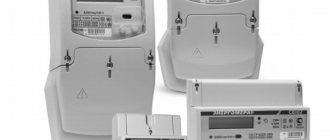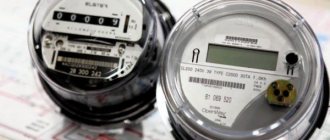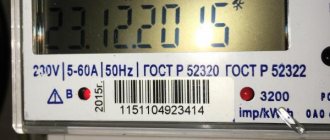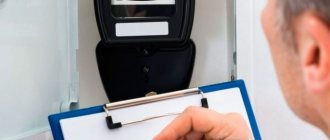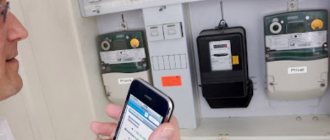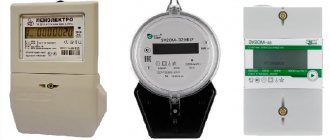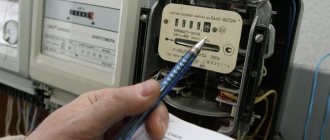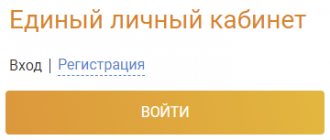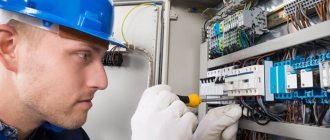How to take readings from a two-tariff device
Many consumers, especially older ones, are faced with questions about how to take readings from a two-tariff meter and the likely complexity discourages them from purchasing a profitable mechanism.
In fact, there is nothing difficult to remove. To make the purchase of a new device worthwhile, you need to use the device correctly and figure out how to take readings from a two-tariff meter. To avoid overpayments according to indications and the accrual of penalties, you must carefully monitor the transmitted indications, recording them monthly (preferably after the 25th day of the month) in a special notebook and paying regularly. A time period is selected on the display (indicated by T01, T02): the readings of electricity consumed during the day are taken into account at the tariff T01, at night - T02. You should press the “Enter” button. After this, at intervals of less than a minute (depending on the manufacturer, model), readings for individual tariffs are displayed
You should pay attention to tenths and hundredths of kW/h - they are separated by a dot, comma or other color. Integer numbers will correspond to the electricity consumed in kWh.
Which electrical appliances can be switched to work overnight?
To get electricity savings with a two-tariff meter, we’ll try to shift the operation of some devices to the night.
- washing machine – 8 kW*hour per cycle (if washed 2 times a week)
- refrigerator - 12 kWh per month (usually they indicate consumption for the year, from here you can easily calculate the daily rate and take 30% for the night rate - if it’s not clear, leave a comment, I’ll write in more detail)
- heater - 45 kWh per month (if turned on every night, although this is unlikely)
- boiler – 45 kW*hour per month (if you set it to heat at night, this is quite realistic)
This is what comes to mind, the rest of the electrical appliances will still be used mainly during the day or evening.
In the current economic crisis, a two-tariff electricity meter is a popular way to save the family budget. This is a way out, because tariffs are rising every day, and family income is not increasing so quickly. But whether a two-tariff meter is beneficial for saving energy, what advantages and disadvantages it has, the installers do not say. Therefore, information from specialists is useful before installation.
Three-phase or single-phase design
When purchasing, it is important to clarify for which network this electric meter model is intended. The signs are as follows:
The signs are as follows:
- A 1-phase device has two terminals on each side, that is, four in total.
- 3-phase has at least four terminals on each side, that is, at least eight in total (there may be additional ones).
Those who live in city apartments need to purchase a 1-phase meter. But owners of private houses, if they do not know the number of phases, should first calculate the number of wires in the line connected to the house. If there are two of them, the network is 1-phase, if there are four, it is 3-phase.
A 3-phase model can be connected to a single-phase network without any problems, so those who currently have one phase, but plan to switch to a 3-phase power supply in the future, can safely purchase a three-phase meter. But, of course, it is impossible to connect a 1-phase meter to a 3-phase network.
The electric meter cannot be returned or replaced if it does not fit. The fact is that when selling a device, a special mark is placed in the passport - because of this, the product, as they say, cannot be returned, unless, of course, a manufacturing defect has been identified.
Therefore, when purchasing, all parameters and characteristics of the meter must be checked with all possible thoroughness.
In addition to phasing, pay attention to:
- rated current: must exceed the maximum of the input circuit breaker by one step;
- accuracy class.
An important characteristic is the noise level (some models buzz).
Procedure
To take readings from a multi-tariff meter, you need to:
- First of all, determine the number of tariffs on the installed meter. There may be two or three. On the first days of the month, it is necessary to write off the readings recorded on the accounting device. On the three-tariff version, these data are indicated: T1, T2, T3. On the two-tariff electric meter, this information is indicated: T1 and T2, respectively. There is no need to write down the entire indicator; you can write down the numbers that come before the decimal point and the one after it. For example, if the display shows 564.233, then you need to enter 564.2.
- To remove the indicators, you must press the “Enter” button. The display will alternately highlight the required combinations T1, T2, T3 or T1 and T2 with a two-tariff view. The button is pressed once, and the device will automatically display the data with a break of 30 seconds.
- After this, it is necessary to determine payment tariffs for energy consumed. If a gas stove is installed in the house and the accounting is kept by a two-tariff device, then the T1 readings (daytime) are paid at a cost of 3.80 rubles, and the T2 data (nighttime) are calculated at 0.95 rubles. If the house has a gas stove and the accounting is kept by a three-tariff device, then the first two costs remain the same, and T3 data is calculated at 3.20 rubles.
If an electric stove is installed in the house, the tariffs change slightly. Indicators T1 with a two-tariff and three-tariff system are calculated as 2.66 rubles, T2 - 0.67 rubles. And half-peak hour (T3) is calculated at the rate of 2.24 rubles.
- Next, fill out the receipt. When multi-tariff accounting is maintained, different payment codes are used. With a three-tariff meter, these indicators are as follows: T1 - 13, T2 - 2, T3 - 15. When a two-tariff meter is installed, the following codes are used: T1 - 1. T2 - 2. From the last readings, you need to subtract the previous indicators of the device and multiply them by the corresponding tariff value.
- Next, the results for three or two obtained indicators are summarized. If the home owner has any benefits, their amount is deducted from the payment amount received. The receipt can be paid at any savings bank or post office.
- If you lose your last payment receipt, all the necessary numbers can be found on the meter. To do this, press the “Enter” button and hold it for 2 seconds. The device alternately displays all previous indicators at the time of the last payment. The multi-tariff meter retains all information about the indicators throughout the entire period of use. This greatly simplifies the comparison of the device readings with the figures of the latest payments.
The benefit in this situation is very noticeable. These devices are a real opportunity to save your own money.
You may find this article about checking electricity meters useful.
Read the article about installing an electric meter in a private home here.
How profitable is it?
It is impossible to say unequivocally whether installing a two-tariff electric meter is beneficial or not. Tariffs in each region of Russia are set separately. In some, the difference between the night tariff and the single tariff can be 3-4 times. But, more often than not, night charges are approximately two times less (compared to day charges). And even under such conditions, you can save a fairly large amount - 1/3 of monthly charges or more. True, for this it is necessary to transfer the operation of electrical appliances to the night. Tariffs for some regions of Russia are shown in the table. It can be used to estimate the difference in tariffs.
Single-zone and two-zone electricity tariffs for 2016 for some regions of Russia
After analyzing the table, you realize that not everything is as rosy as it seemed. In some regions, where daily rates are much higher than single-tariff rates, savings are a big question. The night benefit is eaten up by overpayment during the day. In such areas, everything needs to be carefully calculated (see below for how). When making calculations, you need to take into account that you will buy a new two-tariff electricity meter with your own money, as well as reprogram it if necessary. So for a while you will simply be recouping your investment. And no one is immune from changes in tariffs or the legislative framework. And it may well happen that in a few years it turns out that you pay more on a two-tariff meter than on a single-tariff meter. There are already many such cases.
How you can save money
Modern household appliances may have a delayed start function. Thanks to it, you can do laundry at night, wash dishes in the dishwasher, prepare breakfast (multi-cookers, bread makers and other similar equipment). Some even heat water in storage boilers at night, closer to the morning, by setting timers on them. In addition, a fairly large number of “standard” equipment operate at night - a refrigerator, air conditioners or heating devices. So, it may well be that the consumption at night will be greater than during the day.
Most modern home appliances have a delayed start function.
If the tariffs in your region are “normal” and there are savings, it makes sense to install a two-tariff electricity meter in large families where consumption is high. This system is beneficial for night owls who go to bed long after midnight. Their main activity occurs at night, so the main consumption will be during the lowest rate. But you can accurately determine whether this innovation will give you any tangible benefit or not only after calculations.
Determining economic efficiency
First, you need to find out the dual-zone and single-zone tariffs in force in your region. Then, within a few days (preferably a week), conduct an experiment. Transfer all possible technical processes to the night, and track how much electricity you consume at night and how much at daytime. Readings will have to be recorded manually at 7 am and 11 pm. It is necessary to write down taking into account the decimal places - this way the calculations will be more accurate.
How long do ordinary household electrical appliances last?
You summarize the readings collected over the week - separately for daytime, separately for nighttime. Multiply by the corresponding tariffs. You receive the amount you pay when switching to a two-zone tariff. To have something to compare with, count the total amount of electricity consumed (add the night and day parts) and multiply by the single-zone tariff. Now you can calculate the difference and evaluate whether this idea is worth getting involved with.
Excerpts from the forum
Positive and negative qualities
Why do buyers choose a “day/night” electric meter:
- The first and most important reason is significant savings in money when paying for consumed kilowatts. Of course, this effect is not immediately noticeable, but after a few months the result will be obvious.
- The installation of such electricity meters greatly facilitates the work of companies supplying electricity to the city. The equipment is used less, therefore, there is no need to frequently resort to its repair. This will also be reflected in the amount of raw materials used for refueling.
- It’s hard to believe, but thanks to the “day/night” electric meter, the environment begins to suffer less. Due to the fact that the power plant uses less raw materials for refueling, the percentage of emissions and decay products into the atmosphere is significantly reduced. This is good for everyone: people, plants, animals, the air.
But people are much less interested in environmental problems, just as they think about working as an electricity supplier. Therefore, saving money and utilities in general comes first.
For what reasons do some buyers refuse to install a “day tariff/night tariff” electric meter:
- Not everywhere the tariffs for “day” and “night” kilowatts are the same in cost. For this reason, people do not purchase such a unit for their apartment, they simply do not see the difference.
- Some customers are disappointed in their purchase and say that they do not see any difference between the meter readings at different times of the day. In fact, not all apartment and house owners know how to properly use electrical appliances indoors. The principle is simple: the most powerful energy carriers, such as a boiler or washing machine, are best used after 11 pm.
- Many people naively believe that there is no difference between day/night electricity meters. In fact, there is, it just all depends on the type and its characteristics. But the choice of electricity meter is quite large.
By what characteristics should these units be distinguished from each other?:
- You need to know how many phases there are in the electric meter. There may be two, or maybe three;
- How much incoming electric current the meter can withstand in operation;
- How many zones does the meter have?
- How the electric meter is attached to its place of operation in the corridor: a special rail or drilling holes for bolts;
- How reliably the readings of consumed kilowatts are recorded;
- What does the panel on which the readings are reflected look like?
- What other functions does the purchased unit have?
How to correctly take readings from the device
To figure out how to take readings from an electric meter, you need to know its type. The principle of data recording may differ.
How to read an induction type meter
For old-style products, the numbers are visible on the display. If the wheel moves quickly, the values can change several times a day. The digital series varies within 6-7 units. The latter is often highlighted in color or the window in which it is located is larger than the others. It is not taken into account when fixing values. For a number of devices, any selection is not provided by the manufacturer, so the controller records a completely digital series.
Before reading the meter, the inspector checks the values for the past month or quarter recorded in the journal. The supplier often sends out receipts, which already indicate the difference in indicators after the controller has recorded the current consumption. If the property owner has submitted an application to change the device, then GorSvet is obliged to draw up an act that will display the amount of electricity wasted during the entire operation of the device.
How to take readings from an electronic meter
Electronic devices also have a window, inside which numbers and values periodically appear. They are updated with some frequency, which allows controllers to make calculations using a standard algorithm that is suitable for a single-tariff system.
The multi-tariff meter displays the difference depending on the time of day: at night the values are lower. The data recording algorithm changes slightly (the number of actions increases).
Mercury 200: taking data
Data recording from the Mercury electric meter is carried out in several ways, depending on the model of the device installed inside or outside the building. Multi-tariff ones have markings on the screen. It is fixed by pressing a special button located near the screen.
When using a single-tariff meter, the data is recorded with one press of the “enter” key. The designation T1 appears on the panel. A day-night device requires pressing the corresponding button twice.
How to take Mercury 230 electricity meter readings
Reading data from the two-tariff Mercury is carried out according to a standard algorithm. To record the readings, press the “enter” button once: the text T1 and a series of numbers appear in the window (kWh during daylight hours, from 8:00 to 00:00). The indicators are recorded in the log book.
Then the “enter” key is pressed again so that the T2 mark and other indicators indicating the amount of current wasted per night (from 00:00 to 8:00) are displayed in the window. The value is entered in the appropriate column in the journal.
How to calculate electricity using a multi-tariff meter
The final calculation is carried out using indicators for the previous and current months. Calculation example:
- for the current month: T1 - 1500 kW, T2 - 150 kW;
- for the last month: T1 - 1300 kW, T2 - 100 kW.
Mathematical calculations:
- 1500-150=1350;
- 1300-100=1200;
- 1350-1200=150.
How to read data from the Energomer meter
The main difference between the model and all the others is the presence of a key on the panel, which is designated by the abbreviation PRSM. Multi-tariff products "Energomer" are considered more innovative devices, so the models are almost identical in characteristics. The main disadvantages include the high price.
From the Micron counter
Micron electricity meters have a single key on the panel that needs to be pressed when recording data. After pressing, 2 dots should appear on the screen, moving chaotically around the window. The latter indicates zones divided into tariffs. When the point crosses the border of a particular zone, the display will display numbers indicating the number of kW wasted in 25-30 days. The T1 R+ and T2 R+ markings appear on the screen.
From the Saiman counter
Products of this brand replaced outdated devices from the 80s and 90s. release regardless of the region, so many are satisfied with Saiman devices. They are convenient to use in everyday life: there are no buttons on the display to record data. Numbers indicating the consumed kW appear on the display once a day.
You can track a certain periodicity: first, the device identification code appears, the kW value itself, the date and the inscription “Total”. Single-tariff products are easier to use; data is displayed on them instantly. In two-phase devices, the sequence is shown by zone (T3, T2 and T1).
Shoemakers with and without boots
But our hydroelectric power plants operate not only in Irkutsk. Krasnoyarsk hydroelectric power station operates in Krasnoyarsk
(and there the cost of a kilowatt of electricity is 4 rubles 75 kopecks, which is comparable to prices in St. Petersburg).
the Volzhskaya Hydroelectric Power Station
near Volgograd (where a kilowatt costs 4 rubles 22 kopecks).
In the Samara region there is the Zhigulevskaya hydroelectric power station
(a kilowatt costs 4 rubles 6 kopecks). It turns out that for some reason the residents of Irkutsk enjoy the benefits of being close to a hydroelectric power station, but the rest - not so much.
?
We also produce gas not only in Irkutsk. For example, there are gas fields in Astrakhan, Novosibirskneftegaz is operating in Novosibirsk (although, of course, more oil than gas), the volume of gas produced in Krasnoyarsk is growing. However, in none of these regions gas costs less than three rubles, as in Irkutsk. Moreover, in Krasnoyarsk blue fuel is one of the most expensive in the country
(6 rubles 27 kopecks) - it is more expensive only in Volgograd (8 rubles 97 kopecks), which is located only 300 kilometers from the Astrakhan gas condensate field.
With cold water
everything is also quite strange. The cost of a cubic meter, as it turned out, does not depend either on the size of the city (in Novosibirsk, a millionth city, water is cheaper than in the small 500,000th Astrakhan), nor on the proximity of large water arteries (however, all Russian cities are located near one or another large river), nor from the average salary in the region (if we take into account the salaries of utility workers). What then does it depend on? But we don't know.
Hot water is easier - on average it is 6 times more expensive than cold water
, that's all.
And the prices for garbage
and completely demonstrate unity and equality. Throughout the country, garbage operators have united in a single impulse to charge 90 rubles per person per month. But we can argue endlessly about the quality of waste removal. At least judging by the reviews on social networks, residents of Kazan are satisfied with the cleanliness of their streets, but residents of Samara are not. But perhaps this is due to the excessive pickiness of some citizens, and not to objective problems with export (who are we to judge?).
How are readings taken?
We take readings from the electric meter. Photo No. 3
Readings from any electric meter are taken either by the owners of the facility in which the device is installed, or by authorized persons from the management company that provides utility services to a specific group of people. At the same time, the owner of the property has every right not to allow his meter readings to be taken either by representatives of the management company or by other persons.
In this case, the cost of electricity provision services will be calculated at average regional tariffs.
The actual procedure for taking readings is different for different types of three-phase meters:
- When using a device with an inductive counting form, in order to obtain the required numbers, it is necessary to copy the available readings on the rotating display of the device onto a piece of paper. If one or two digits, usually out of five or six in general, have a different color than the rest, then when readings are taken, these numbers are discarded (they show an intermediate calculation of electricity consumption on a small scale, so they are not taken into account when determining monthly readings).
- When using an electronic meter, you will have to refer to its instructions. The fact is that different models of meters show 10-15 seconds: time, date, power consumption indicators for all time and by periods (T1 - 7-23:00, T2 - 23-7:00, T3, T4, etc.). d. – grace periods). As a rule, the sequence of displaying values corresponds to that described above, however, for the most accurate determination, you should refer to the previously mentioned counter instructions.
Taking readings from a three-phase meter is only half the battle. Next you will have to do the following:
- Determine how much electricity was consumed over the last month. To do this, it is enough to take the meter readings for the previous month and subtract them from the currently available ones. You can find out these readings either by monthly recording, or by looking at the last paid receipt for electricity.
- Multiply the resulting electricity figure by the current tariff in your region. So, for example, with an electricity consumption of 200 kW per month and a tariff of 4 rubles per 1 kW, you will have to pay 200 * 4 = 800 rubles.
As you can see, there are no particular difficulties in working with three-phase electric meters and taking readings from them is as easy as shelling pears. We hope the material presented above was useful to you. Good luck paying your utilities!
You can learn about the procedure for taking and transmitting electric meter readings by watching the video:
Energy meters
Taking readings from the Energy Meter day-night electricity meter (two-tariff or multi-tariff) occurs in exactly the same way. The difference is that the button on these electricity meters is called “PRSM” (view). There may be two or three buttons, depending on the modification.
Electricity meter Energomera CE301
When you click on this button, numbers appear showing how many kilowatts were “increased” for each tariff zone. There are no more differences.
Read more: Up to what age is a ticket considered a children's bus?
Take readings from the Micron electricity meter
In Mikron multi-tariff electronic electricity meters, there is only one button on the case, and you need to press it to display the required readings on the screen. Only in this case, you need to wait until “checkmarks” appear on the display above the letters “T1” and “R+” (see photo). This will be the reading for the first tariff.
How to take readings from the Micron electric meter model SEB-1TM.02M
Then click on the same button until the checkmarks appear above T2 and R+, if there are more zones, click further. This is how readings are taken from this day/night meter.
Saiman counters
Now in many regions they replace old induction meters with electronic ones free of charge and most often install devices from Saivan. These are very simple devices; they do not have buttons that can be used to forcefully “scroll through” the readings. You just have to wait until the required value is displayed. That is, in this case, take readings from the electricity meter - just wait until the required value (TOTAL) is displayed and write it down on the receipt (or transfer it to the appropriate service).
To make it easier to navigate, here is the order in which the data is displayed in this electric meter:
- date of;
- time;
- meter number;
- gear ratio (1600);
- TOTAL - readings of a single-tariff meter or are displayed sequentially T1, T2, TOTAL for day/night type meters (two-tariff).
It is necessary to record the TOTAL or T1 and T2 readings and also the general TOTAL readings on the receipt. Let us remind you once again that you only need to write down the whole part, without taking into account the numbers after the decimal point. You can watch the same information in video format.
Electricity tariffs in Moscow from January 1, 2022
| 01.01.2021 30.06.2021 | 01.07.2021 31.12.2021 | |
| Single-tariff accounting using a single-rate tariff | 4,01 | 4,29 |
| Two-tariff metering using a tariff differentiated by day zones | ||
| night zone T2 (23.00-7.00) | 1,76 | 1,91 |
| day zone T1 (7.00-23.00) | 4,61 | 4,93 |
| Multi-tariff metering using a tariff differentiated by day zones | ||
| night zone T2 (23.00-7.00) | 1,76 | 1,91 |
| half-peak zone T3 (10.00-17.00; 21.00-23.00) | 4,01 | 4,29 |
| peak zone T1 (7.00-10.00; 17.00-21.00) | 5,21 | 5,58 |
Now there are two different single-rate tariffs - for those who have gas stoves and for those who have electric ones. That is, all electricity consumed is calculated at one tariff. For the former, the tariff will increase to 0.2092 rubles per kWh (currently 0.1901 rubles), for the latter - to 0.1778 rubles per kWh (currently 0.1616 rubles). That is, growth is about 10%.
Let us remind you that in Belarus back in 2022, electricity consumption limits were abolished. This means that no matter how many kWh a person consumes - 150, 250 or more, he pays the same tariff for them.
There are also electricity tariffs based on the time of day. For those apartments in which an electric stove is installed, the tariff for two time periods from January 1 will increase by an average of 10%: from 22.00 to 17.00 - up to 0.1245 rubles per kWh (now - 0.1131 rubles), from 17.00 to 22.00 - up to 0.3556 rubles per kWh (now - 0.3232 rubles). That is, energy costs less during the day and at night, and more expensive in the evening.
The electricity tariff for three time periods (we are talking about apartments with electric stoves) from January 1 will be: from 23.00 to 6.00 - 0.1067 rubles per kWh (now - 0.097 rubles), from 17.00 to 23.00 - 0.32 rubles ( now - 0.2909 rubles), the rest of the day - 0.1245 rubles (now - 0.1131 rubles). That is, at night electricity is cheapest with this option. You can choose a tariff at your discretion.
Tariffs for apartments with gas stoves will also increase by time of day and time period. The tariff for two time periods will increase from January 1: from 22.00 to 17.00 - to 0.1464 rubles per kWh (now - 0.1331 rubles), from 17.00 to 22.00 - to 0.4184 rubles per kWh (now - 0.3802 rubles). The tariff for three time periods from January 1 will be: from 23.00 to 6.00 - 0.1255 rubles per kWh (now - 0.1141 rubles), from 17.00 to 23.00 - 0.3766 rubles (now - 0.3422 rubles) , the rest of the day - 0.1464 rubles (now - 0.1331 rubles).
Those who want to heat their homes with electricity can choose one of two tariffs. The first option is a one-rate tariff, which applies to both heating and all other needs. This tariff will increase from January 1 to 0.0894 rubles per 1 kWh (currently 0.0834 rubles), and from June 1 - to 0.0909 rubles. This year, these tariffs were also increased twice. There is no need to install a special separate heating meter. This tariff can be used by both owners of private houses and residents of apartment buildings. For example, if you spend 350 kWh per month, then now the payment is 29.19 rubles, and from January 1 - 31.29 rubles, and from June 1 - 31.82 rubles.
Another differentiated tariff is for two time periods. Like the single-rate tariff, this one applies to both heating and all other needs. There is no need to install a special separate heating meter. During the period of minimum load (from 23.00 to 6.00), the tariff from January 1 will be 0.0626 rubles per 1 kWh (now - 0.0584 rubles), and from June 1 - 0.0636 rubles. For the rest of the day, from January 1, electricity will be charged at a tariff of 0.1162 rubles per 1 kWh (now - 0.1084 rubles), and from June 1 - at 0.1182 rubles. If you spend 350 kWh per month (from 23.00 to 6.00), then now the amount due is 20.44 rubles, from January 1 - 21.91 rubles, and from June 1 - 22.26 rubles.
The third option is to install an additional special meter, which now counts the electricity spent on heating at a rate of 0.0374 rubles per 1 kWh. From January 1, this tariff will not be increased, and from June 1, it will increase to 0.0398 rubles. At the same time, the rest of the electricity consumed, including for cooking, washing, lighting the house, is calculated according to the second main meter and was paid according to one of the existing tariffs - according to the volume or time of consumption. This tariff is popularly called “three kopecks”.
Types of three-phase multi-tariff meters
According to the type of design, three-phase metering devices are divided into 2 groups:
- electronic - transmit the number of counted pulses to the controller;
- induction - read the number of revolutions from a disk that moves through a magnetic field.
According to the type of connection, the following three-phase multi-tariff meters are distinguished:
- straight;
- semi-indirect;
- indirect.
The direct connection device is connected to the cable distribution, the cross-section of which varies between 15-25 mm2.
The maximum current parameter of three-tariff devices is no more than 100 A, and the power is 60 kW.
Instructions for installing the meter are indicated in the instructions. Installing a three-phase device is quite complicated; the devices are designed for heavy loads, so it is recommended that an experienced electrician carry out the installation work.
What do you need to know?
- When planning to take readings from a two-tariff meter, use a piece of paper and a pencil, because you are unlikely to retain a large series of numbers in memory, and the slightest mistake will lead to incorrect calculations.
- Check the electricity meter regularly for physical damage.
Important! If you find defects in the form of a broken seal, erased numbers or a faulty case, immediately contact your utility service. Refrain from taking readings until you consult a specialist.
- When installing the device, you must receive a passport with the specified date of verification of the mechanism. When installing the device, the RES employee must explain how to maintain a two-tariff electricity meter and how to take readings correctly.
- Don't try to fool the technology. Modern technologies will definitely reveal the deception, and the violator will be punished with a fine for an offense.
Important! Damage to the meter mechanism due to the fault of the apartment owner is subject to administrative punishment.
Rules for taking readings from electronic electricity meters
Devices of this type are equipped with an electronic display containing information relevant to the user. Here you can find not only current energy consumption readings, but also information regarding the date and time of operation of the device. For most models, this data replaces each other on the display with a specified frequency. For multi-zone models, readings are displayed in the corresponding zone.
To take readings, just wait until the relevant information appears on the electronic electricity meter. You can also press the corresponding “enter” button several times until the display displays the relevant information, which should be written down on a specially prepared piece of paper.
It is necessary to take readings from electronic devices according to all the rules
How to take readings from the Mercury 200 meter
The manufacturer offers two types of devices: single-tariff and multi-tariff. The first ones are marked as 200.00. Multi-tariff ones have not two zeros after the dot, but a certain digital value: 01, 02 or 03. Some models are supplied with a control panel and may have a different number of zones on the display.
The display of the Mercury 200 device alternately displays:
- time;
- date of;
- tariffs by zone, indicating additional tariffs. The marking appears in the upper left corner. Tariffs are displayed one by one, which allows you to record readings of consumed electricity. Values after the decimal point should be discarded.
The data is changed after 5÷10 seconds. If this time is not enough, you can switch tariffs using the “Enter” button.
The display of the Mercury 200 meter displays all the necessary information
How to take Mercury 230 electricity meter readings
The model is three-phase. Calculation of readings is carried out at once according to several tariffs. On the device display you can see data related to a specific tariff.
Let's look at how to take Mercury 230 electricity meter readings
You should pay attention to tariff zoning:
- T1 – peak zone;
- T2 – night period;
- T3 – half-peak zone;
- T4 – grace period.
Light meter readings are taken in the following sequence:
| Photo | Description of operations |
| The “ENTER” button on the front panel allows you to switch the displayed information. | |
| Tariff T1 corresponding to the peak zone. The numbers up to the decimal point are significant. | |
| After pressing the “ENTER” button, the readings corresponding to the T2 tariff are displayed. | |
| Another press will allow you to see the readings for the third tariff. | |
| A subsequent press will display the data for T4. | |
| If payment is not made at a differentiated rate, you should press the button again to see the total value. |
How to take energy meter readings Energomera
The manufacturer offers the device in various modifications. You can choose a single or multi-tariff meter. The latter are more popular. The number of buttons on the front panel of the meter depends on its design features. As a rule, there are 2 or 3 of them. The data is reflected by tariff zones.
To view digital values, press the “PRIM” button. If you still have questions about how to read the electricity meter, you should carefully read the instructions included with the meter.
“Energomera” is a device that has various modifications
How to take readings from a Micron meter
Multi-tariff device equipped with an enter button. To display the necessary readings, press it sequentially so that the current values appear on the display. “Ticks” will appear opposite the tariff marking, for example, T1 and the value that should be taken into account when calculating (R+). This is done so that the subscriber knows exactly what electricity meter readings need to be transmitted. By subtracting the readings for the previous month from the current value, you can find out the consumption according to the T1 tariff. To move to the readings corresponding to the next zone, press the enter button, after which the “tick” from T1 moves to T2.
"Mikron" - multi-tariff metering device
How to take readings from a Saiman meter
The device is simple in design. Saiman counters do not have a special input button designed to scroll through data. To read the current values, you have to wait until the symbol TOTAL and numerical data appear on the device display. The information is displayed in the following sequence:
- date of;
- time;
- device number;
- gear ratio (1600);
- If the meter is single-tariff, the current reading is immediately displayed; if it is a two-tariff meter, T1 and T2 are displayed sequentially.
Saiman is a high-quality device with a simple design
The principle of operation of the electric meter
Two-tariff and conventional electricity meters operate in many ways the same. They receive information about energy consumption from current and voltage sensors that are located in them. After which it is converted and the final results are displayed on the liquid crystal screen of the device.
Many two-tariff devices independently transmit all the data they receive to the electricity supplier using secure radio communications. Thanks to this, it is possible to constantly monitor the electricity consumption of each apartment and issue an accurate monthly bill to its owner.
More expensive models are equipped with an interface for connecting to a PC. Thanks to this, it is possible to use them in the Smart Home system.
When installing a two-tariff meter, a program is installed in it to account for electricity consumption at a low cost from 23:00 to 7:00. Simply put, energy consumption is automatically calculated and displayed on the device display in the form of digital information using tariffs T1 and T2.
In addition, on the screen you can see the time and the total amount of energy you have consumed.
Basically, new meter models are equipped with liquid crystal screens, from which digital values can be easily read.
The amount of money that needs to be paid for electricity is calculated in the usual way for everyone. It is necessary to subtract the data from the previous month from the value obtained this month, after which the resulting difference must be multiplied by the cost of 1 kW.
Functionality
Models with advanced capabilities are equipped with a network interface. It provides a connection to a personal computer. Thanks to specialized software, you can keep track of electricity consumption and transmit readings.
The digital meter may contain memory cells that allow you to record readings by month. This function allows you to avoid conflict situations in the event of an erroneous invoice.
It is also possible to view current indicators:
- current consumption;
- tension;
- power (active or reactive).
Manufacturers and prices
Electricity meters of any type are single-phase and three-phase. Two- and multi-tariff too. There are no differences in this, as well as in appearance. The difference is usually in price, but this is understandable - more complex equipment has a higher cost.
The most in demand on the market are two-tariff electricity meters from the Moscow Electrical Instruments Plant (MZEP). It’s not so much about the quality (it’s average, by the way), but about the price - these are the most inexpensive metering devices of this type. The company produces two-tariff energy meters SOE-55. They are available in eight modifications. They differ in the maximum current they are designed for and the number of zones that can be programmed. Any model can have two types of housings: for installation on a Din-rail or in a special box. The price of two-phase electricity meters SOE-55 is from $20 to $30, and this is in the retail chain.
Two-tariff energy meters SOE-55 in two cases - on a DIN rail and in a box
Energomer meters are available with the marking 102 in 4 modifications, with the marking 208 - in two. Each of the modifications can be made in several housings - a standard one for mounting in a box and one with protrusions for a DIN rail. There is also a housing with a remote reading indicator.
According to reviews, the units are quite good; products of this brand are distinguished by powerful terminals for connection, which is always good. They also have a warranty period of 5 years from the date of issue. In terms of prices - simple models cost about $23, with a remote control - $130.
Two-tariff electricity meter Energomera CE 102
Quite popular products from Moscow are Mercury counters. There are three modifications of multiphase meters of this brand: Mercury 200, 203 2T, 206. They can count 4 different tariffs, it is possible to program up to 8 zones per day, set 8 types of days (sometimes weekends and holidays are also counted at a reduced tariff). It is possible to set up to 12 seasons. Cost from $25 to $70 (depending on the degree of sophistication).
Meter Mercury 200 for electricity metering at two (three) tariffs
A two-tariff electricity meter is connected in the same way as a single-tariff one. There is no point in dwelling on this, everything is described here .
Why does the meter consume a lot of energy?
And before considering the immediate causes of phenomena that can generate more electricity than necessary, it is worth analyzing the likely sources of distortion of real results. As a rule, these are:
- Season. In winter, the use of light and heat-producing devices increases. This is not entirely obvious and a person does not always notice that he has begun to use more than usual.
- Replacement of conventional devices. If the meter has a disk, then it may not respond to a small device, but if it is a digital version, then the count will be kept until the phone is charged.
- Meter components. If the device itself is assembled from cheap materials, then the accounting will be exceeded several times only due to technical instability.
- Wear. It can be either during prolonged use or under constant high load. Nothing but replacement can be done here.
There is no perfect device, and therefore absolutely everyone can have distortions
It is important to understand where the indicator deviates from the norm and where it shows a completely incorrect result.
Types of tariff systems
There are two types of tariff systems that take into account the cost of kW of electricity:
The latter are divided into two-tariff and multi-tariff.
Two-tariff systems provide for calculation of use at night and day rates separately, from 7 to 23 and from 23 to 7 hours, respectively. In the case of multi-tariff systems, the division occurs in three zones:
The daytime tariff is the most expensive, the half-peak tariff is no different from the usual one, and the night tariff is reduced.
Special options for tariff systems include payment according to the social norm and payment without meter data.
The principle of operation of a two-tariff meter or how electricity consumption is calculated
A meter that counts according to two tariffs looks similar to a regular one. It has two display screens. One calculates daily consumption, and the other calculates nighttime consumption. The “day zone” is from 7 a.m. to 11 p.m., and the “night zone” is from 11 p.m. to 7 p.m.
The following tariffs apply in the Moscow region:
Let's calculate whether there will be any benefit from splitting tariffs. The tariff for a regular meter is 5.38 rubles/kWh and the tariff, differentiated day/night: the cost during the day is 6.18 rubles/kWh, at night – 2.29 rubles/kWh. So, if you use two-tariff metering, then during the day you pay 80 kopecks more for one kWh, and at night you save 3 rubles 9 kopecks for one kWh. To equalize consumption, it is necessary that for each kWh used at night, there should be no more than 3.86 kWh of the “day zone”. If the ratio is higher, then there will be no savings; on the contrary, it will be more expensive.
Accounting principle
A multi-tariff device helps keep records according to day/night standards.
The essence of this device is that it keeps track of consumed electricity not with one indicator, but with several.
In this case, there is a clear distribution of payment.
These are the following types:
- payment during rush hour (this is the morning hours from 7 to 10, and the evening hours from 17 to 21 hours);
- payment during half-peak period;
- and the lowest cost is the night rate.
Multi-tariff mechanisms in domestic houses and apartments began to be installed quite recently. But experts unanimously assure that these mechanisms are very useful.
Many people do not want to install this type of metering because they are confident that the process of taking readings and calculating the amount of payment for consumed electricity is highly complex. But things are not as complicated as they seem.
For calculations you need to prepare:
You may be interested in an article about Mercury two-tariff electricity meters.
Read an article on how to properly seal an electricity meter here.
How to calculate electricity if there is no meter
If a meter is not installed in the house or its calibration interval has expired, then it is impossible to transmit the readings. In such situations, accruals are made according to the standards, that is, according to the indicator established in the region. Here it is worth considering that the energy supply company has the right to apply an increasing factor of 1.5 if residents have the technical ability to install a meter, but they do not do this for some reason.
The following indicators are taken into account:
- Number of permanently and temporarily registered persons.
- Living space area.
- The current standard in the region.
All data is multiplied and, if necessary, increased by a factor of 1.5. The result is the amount to be paid.
Electricity consumption rates without a meter directly depend on the following points:
- Number of rooms.
- Number of residents, including those temporarily registered.
- The region where the object is located.
- Type of stove installed (gas or electric).
Methods for transmitting readings
There are several ways to transfer information about energy consumption data to the organization that is the supplier:
- Go to the company yourself . The information taken from the meter and entered into the required document is taken to the company. Here you have the opportunity to pay immediately for the services provided.
- You can transfer information remotely via computer . To do this, you need to log in to the service provider’s website. The readings are transmitted through your personal account or the corresponding fields on the website.
- Some multi-tariff meters are multifunctional devices , and therefore can themselves send data on energy consumption. If this service is activated, then there is no need to remove or calculate anything - the meter will independently perform all operations automatically.
Description
Electricity consumption is recorded using a meter at a certain tariff. However, in practice it is known that at certain times of the day energy consumption is more intense than at others. Therefore, organizations selling this resource enable consumers to switch to different tariffs depending on the time of day.
Tariff validity periods
The benefit of switching to three-tariff metering is that if the consumer distributes electricity consumption in such a way that the most energy-intensive actions are performed during the period with the minimum tariff, then he will be able to save on payments. It should be taken into account that night rates may differ from day rates by four times.
When using three-tariff metering, the highest cost of electricity will be at the time of day when its consumption is maximum. At half-peak consumption, the tariff will be less high, and during the night it will have a minimum value.
Types of counters
Pros and cons of equipment
Even the most modern electronic technology, presented by manufacturers as the most profitable, has not only advantages, but also disadvantages.
The characteristics due to which this equipment is in demand among consumers include the following:
- multi-tariff meters are highly accurate and do not take into account extra kilowatts;
- with proper organization of the operation of household appliances, the price of electricity with a two-tariff meter will be less than when using a conventional meter;
- Despite the high cost, with a large number of household appliances, the equipment quickly pays for itself due to a differentiated tariff.
If you use powerful household appliances - climate control equipment, heat and water pumps, heating boilers and boilers - mainly during the night electricity tariff, the meter will pay for itself quickly enough.
Among the disadvantages of this metering device, the only thing that can be noted is that in apartments with low daily electricity consumption, the savings will be insignificant, and the payback of the metering device will be long.
It is possible to say with certainty which electricity tariff is more profitable only after an audit of energy consumption for an individual apartment.
Mercury counters: varieties
First you need to familiarize yourself with all the Mercury meters that have gained popularity in our country. Let us note the fact that the Incotex company, which is a manufacturer of these units, has been a leader in modern markets for quite some time and produces not only electric meters, but also many other electronic equipment.
So, among the best Mercury counters are:
- Mercury 200;
- Mercury 201;
- Mercury 221;
- Mercury 230;
- Mercury 231;
- Mercury 321.
Separately, you should pay attention to the 200 series. Such units are mainly used in single-phase networks, with alternating current in the main circuit
In nominal metering, voltage is coded in volts. In this situation, electricity metering is done according to a single tariff plan.
The 201 series meters are considered to be the most popular. They have become widespread and therefore are currently used as the main installation for monitoring electricity metering not only in private homes, but also in enterprises. Such meters are the most functional; they can be not only single-phase, but also two-phase. As for the design, it is of excellent quality and is protected from any type of hacking.
An electric meter from this manufacturer can be:
Each electric meter requires a separate approach, and it is very important to know how to correctly take readings from them. The meter must be installed by a person from a special service, who will put a seal after installation
The meter must be installed by a person from a special service, who will put a seal after installation
This category includes several more serious types of counters:
All of them are used depending on the area in which the measurement should take place. The listed types are designed to operate with a rated current of 5A, while the maximum operating mark is 60A.
Advantages of the device
The model has the following advantages:
- reasonable price;
- long service life and reliability;
- optimal manufacturer's warranty;
- multifunctionality and the ability to connect to third-party devices;
- the presence of protection from external influences;
- long calibration interval;
- low own power consumption and the presence of built-in power supply;
- modern design.
We recommend: Energy meter TsE6803V - description and technical characteristics
The device meets established quality standards and has passed the necessary certification.
Selecting a period and fixing the period
The first press of it will turn on the backlight, and further presses will change the contents of the digits (we are talking about the counter working in edit mode, not viewing mode).
You can switch the device to the adjustment mode by pressing the “DSTP” button twice.
The first row is the date and time. When the first day (hours) flashes, use the “Select” button to select the desired time. Then “DSTP” again – the minutes will flash, set them with the “Select” button. Also seconds, date, day of the week.
If the date and time were set via a computer using the Admin Tools program, the date is fixed using the “DSTP” and “write” buttons (factory default password 777777). Finally, press the “DSTP” button again and the time countdown begins.
Logging in as User gives access to many data and settings. The “User” can change the time once a day for no more than 4 minutes. To have full access to the settings, you must log in as Admin.
Programmable meter
By the way, modern meters have banks with information. One of them stores the total consumption since the device began operating, in the other you can view readings for the last 11 months.
How to choose the right electric meter
The market offers a fairly wide selection of manufacturers of modern models, which are definitely better than the old ones. To choose the right device, you need to pay attention to the following characteristics:
- Type of power supply: single-phase or three-phase. In apartments and small garages, single-phase devices are installed, since a voltage of 220V is sufficient for these electrical networks. Owners of large cottage houses, industrial garages and enterprises will need to install a three-phase device with a voltage of 380V, since these are premises with increased consumption of electrical energy;
- Number of tariff intervals;
- Additional features such as surge protection.
Important! To the big advantages of modern models, it is worth adding the ability to record previous readings, which eliminates the need to carry out long footcloths with calculations. And some models automatically submit readings to the power supply organization, which generally frees the consumer from the need to write out and count anything.
But even if you choose a more modest device, today there are more than enough ways to transmit readings - this is the Internet, and the telephone, and a receipt in the mailbox.
